Cross Site Request Forgery- Type Setter CMS 5.1-CVE-2018-6888

Hi Readers, Recently while performing some open source security assessment, I came across an CMS “ Typesetter” CMS. Curious to explore its functionalities, I set up a local copy and started playing around to find security vulnerabilities’. Title of the Vulnerability : Cross Site Request Forgery. Vulnerability Class : Remote Code Execution/ Account takeover Technical Details & Description : The application source code is coded in a way which allows malicious crafted HTML page to be executed directly without any anti csrf countermeasures. CVE ID allocated : CVE-2018-6888 Product & Service Introduction : TypeSetter 5.1 Steps to Re-Produce – 1. Visit the application 2. Visit the User Permissions Page. 3. Goto add user, and create a csrf crafted exploit for the same , upon hosting it on a server and sending the ...







